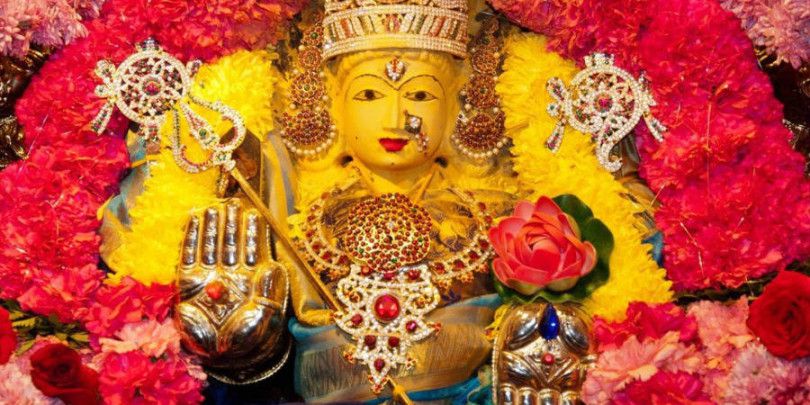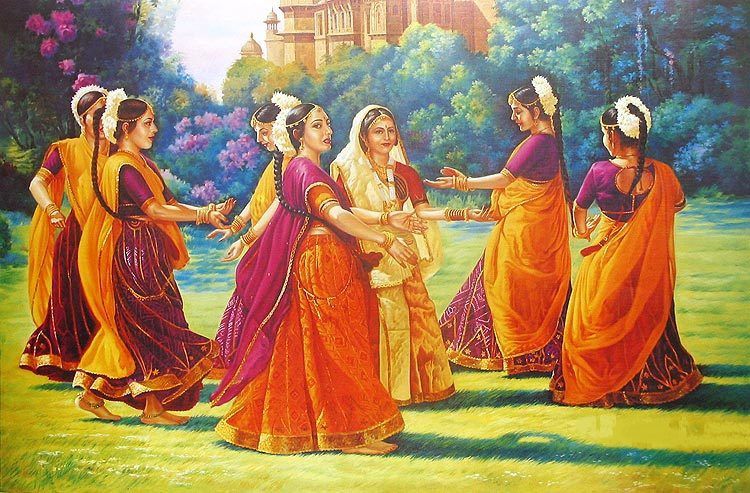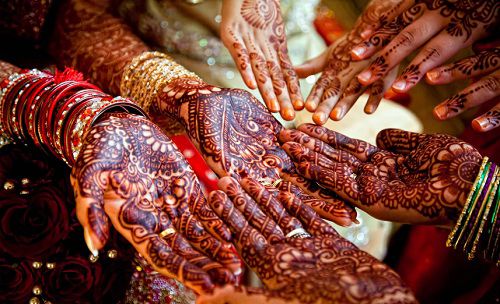No products in the cart.
Teej in Hindi literally means “three” it is the third day of the month. According to the Hindu calendar there are two teej in every month (30 days). Special significance is given to teej (or the third day) of special months. The Hindu festival of Teej is marked by fasting of women who pray to Lord Shiva and Goddess Parvati seeking their blessings for marital bliss. It is a series of festivals that occur during the Hindu month of Shravana or Sawan and Bhadrapada or Bhado, that corresponds to the Indian monsoon season of July – August – September.
History and Origin of Teej
It is believed that the name of this festival comes from a small red insect called ‘Teej’ that emerges from the earth during the monsoon season. Hindu mythology has it that on this day, Parvati came to the Shiva’s abode, marking the union of the husband and wife.
Teej symbolizes the reunion of Shiva and his wife Parvati. It exemplifies the sacrifice of a wife to win the mind and heart of the husband.
According to myths, Parvati carried out a rigorous fast for 108 years to prove her love and devotion for Shiva, before he accepted her as his wife. Some scriptures say that she was born 107 times before she was reborn as Parvati, and at her 108th birth she was granted the boon to be the wife of Shiva because for her long penance and perseverance over many births. Hence, Teej is celebrated to honor the devotion of Parvati, who is also known as ‘Teej Mata,’ by those who observe this auspicious day when women seek her blessings for a happy married life and a good husband like Shiva.
Teej – A Regional Monsoon Festival
Teej is not a pan-Indian festival. It is mainly celebrated in Nepal and the northern Indian states of Uttar Pradesh, Bihar, Rajasthan, Haryana, and Punjab in various forms. In northern and western India, Teej celebrates the arrival of monsoon following the hot months of summer. It has a broader significance in the western Indian arid state of Rajasthan as it is observed to provide relief from the scorching heat of summer. Rajasthan Tourism organizes a Teej fair called ‘Sawan Mela’ or ‘Monsoon Festival’ every year to showcase the customs and traditions of the state during this time. It is also celebrated in Hindu Himalayan kingdom of Nepal, where Teej is a major festival. At the famous Pashupati Nath Temple in Kathmandu, women circumambulate the Shiva Linga and perform a special Puja of Shiva and Parvati.
The 3 Types of Teej
There are three types of Teej festivals celebrated during the monsoon months.
The first is the Hariyali Teej aka Chhoti Teej or Shravana Teej, which falls on Shukla Paksha Tritiya or the third day of the bright fortnight of the Hindu monsoon month of Shravana. This is followed by Kajari Teej aka Badi Teej, which comes after 15 days of Hariyali Teej. The third type of Teej, Haritalika Teej comes one month after Hariyali Teej, which is observed during Shukla Paksha Tritiya, or the third day of the bright fortnight of the Hindu month of Bhadrapada. (Please note that Akha Teej does not belong to this category of festivals as it is another name of Akshaya Tritiya or Gangaur Tritiya.
Hariyali teej
Hariyali Teej also called Teejen is celebrated with extreme mirth and devotion by womenfolk. It falls in the Shukla Paksha of Shravana, corresponding to the month of August. As the name says, Hariyali Teej relates to greenery. On this day, many women clad themselves in green colored clothes and wear green bangles. A special puja is performed to worship moon. Traditional singing of songs and dance escalates the verve of Hariyali Teej celebrations.
Hariyali Teej Celebrations
A day before Hariyali Teej, women celebrate ‘Sindhare’. It is a significant day for newlywed brides. On her first “Sindhara” after marriage, it is customary to receive clothes and ornaments from her Mother-in-law. On Hariyali Teej, women gather to worship moon. The puja performed on this occasion is done with milk, curd and flowers.
Hariyali Teej is mainly related with greenery and commemorates for abundance of greenery and good harvest. Women wear green colored clothes like lehanga, suits and saris. They wear green bangles and adorn their hands with beautiful mehendi patterns. Women both married and unmarried enjoy the festive spirit by swinging on adorned swings singing songs relating to the month of Sawan. Various delicious food items are cooked which is relished by all in the family.
The day is enjoyed with full craze that even the Gujarati women adopt the Rajasthani traditions. In Gujarat, special Garba dance is arranged. Women in their traditional clothes, carry pots on their heads and dance singing songs in praise of Goddess Parvati.
In Maharashtra, women wear green bangles, green clothes, golden bindis and kajal for luck. They distribute beautifully painted coconuts to their female relatives and friends and offer fresh fruit and green vegetables to the goddess as thanks giving.
Kajri teej
Kajari Teej or Badi Teej is a special festival. It is celebrated throughout the Northern and the Western parts of India. The celebrations are conducted with much fanfare throughout the states of Bihar, Madhya Pradesh, Uttar Pradesh, Gujarat and Rajasthan. Kajari Teej is celebrated during the Shravana month.
Grand Celebrations on Kajari Teej
The festival is celebrated with much enthusiasm throughout Rajasthan particularly in the city of Bundi. The city is specially decorated for the day. The idol of Goddess Parvati is taken in a procession throughout Bundi. The palanquin carrying the image of Goddess Parvati is accompanied by numerous camels, elephants, musicians and folk dancers. This adds a unique blend to the festivities and makes the occasion special for devotees. The celebrations hold special significance for women in Rajasthan and preparations begin days ahead for the festivities.
Young girls perform dances like Kalbeliya, Bhavia and Ghoomar on the occasion of Kajari Teej. The festival holds a special significance for married women. Women pray for the safety of their husbands on this day. They sing, dance and stay awake all night to add a distinct touch to the festival. A lamp is specially lit and it is ensured that the flame does not diminish throughout the night. Legends associated with Kajari Teej are also shared by the womenfolk among themselves during the course of celebrations.
The celebrations are unique and married women dress especially for the day. The married women apply mehendi on this day and dress up like a newly wedded girl.
Haritalika teej
Haritalika is the amalgamation of two words ‘Harat’ and ‘Alika’, while Teej means the third day. Therefore, Haritalika Teej is celebrated on the third day of Shukla Paksha (bright fortnight) in the Hindu month of Bhadrapada. The day of Haritalika Teej is popular in the states of Madhya Pradesh, Bihar, Jharkhand, Chhattisgarh, and Maharashtra. Haritalika Teej is observed by both, married women and maidens. It is celebrated in the honor of the divine bond between Lord Shiva and Goddess Parvati.
Hence, Haritalika Teej is followed as the day of reunion of Goddess Parvati and Lord Shiva. The rituals and traditions associated with the day of Haritalika Teej are:
- On the day of Haritalika Teej, women get up early in the morning and take a holy bath, meant to purify their souls.
- Concluding this, they dress up elegantly in special attires (mostly Saris) and jewelry, and visit temples on Haritalika Teej.
- Women observe a Nirjala fast (even water is not consumed during this fast) on this day. This is also popular as Haritalika Teej Vrat.
- After conducting rituals at a temple, women return home and touch their husbands’ feet (In India, husbands are considered to be equivalent to god for women).
- Before sunset, bath is once again taken by women and they get dressed as newly-wed brides.
- Then, the worshiping rituals resume. Devi Parvati and Lord Shiva idols made of sand and clay are placed at Puja Sthan (worshiping place).
- Offerings of Bilwa leaves, flowers, incense sticks are made to the deities. This is followed by a meditative practice done in the honor of Lord Shiva and Goddess Parvati.
- At the end, Haritalika Teej Vrat is recited by the devotees.
- Haritalika Teej Vrat is terminated the next day morning, when a devotee completes all the worshiping rituals.
Significance of Teej
The importance of Teej is mainly two-fold: First, as a festival for women, Teej celebrates the victory of a wife’s love and devotion towards her husband – an important factor in Hinduism – symbolized by the union of Shiva and Parvati.
Second, Teej ushers in the advent of the monsoons – the season of rains bringing in a reason to celebrate when people can take a break from the sweltering heat and enjoy the swing of the monsoon – “Sawan ke jhooley.” Besides, it’s an occasion for married women to visit their parents and return with gifts for their in-laws and spouse. So, Teej provides an opportunity to renew family bonds.








